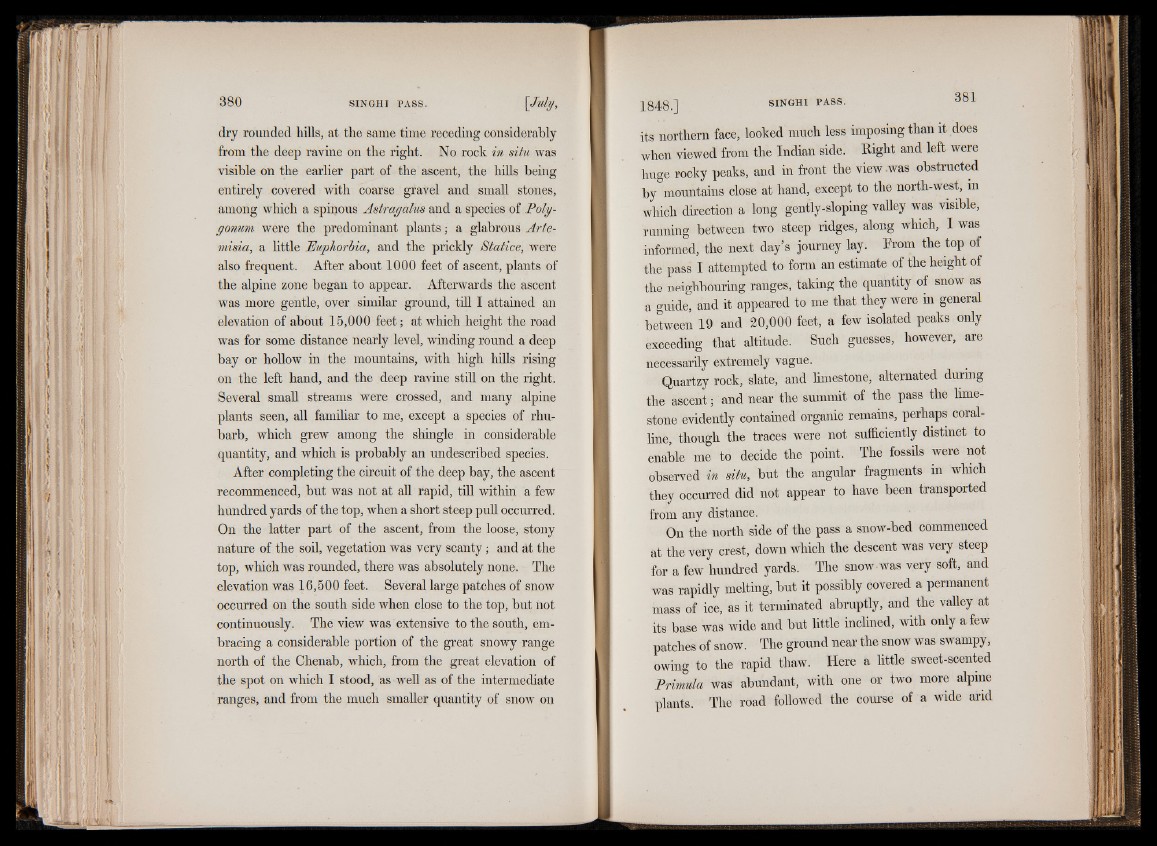
dry rounded hills, at the same time receding considerably
from the deep ravine on the right. No rock in situ was
visible on the earlier part of the ascent, the hills being
entirely covered with coarse gravel and small stones,
among which a spinous Astragalus and a species of Polygonum
were the predominant plants; a glabrous Artemisia,
a little Euphorbia, and the prickly Statice, were
also frequent. After about 1000 feet of ascent, plants of
the alpine zone began to appear. Afterwards the ascent
was more gentle, over similar ground, till I attained an
elevation of about 15,000 feet; at which height the road
was for some distance nearly level, winding round a deep
bay or hollow in the mountains, with high hills rising
on the left hand, and the deep ravine still on the right.
Several small streams were crossed, and many alpine
plants seen, all familiar to me, except a species of rhubarb,
which grew among the shingle in considerable
quantity, and which is probably an undescribed species.
After completing the circuit of the deep bay, the ascent
recommenced, but was not at all rapid, till within a few
hundred yards of the top, when a short steep pull occurred.
On the latter part of the ascent, from the loose, stony
nature of the soil, vegetation was very scanty; and at the
top, which was rounded, there was absolutely none. The
elevation was 16,500 feet. Several large patches of snow
occurred on the south side when close to the top, but not
continuously. The view was extensive to the south, embracing
a considerable portion of the great snowy range
north of the Chenab, which, from the great elevation of
the spot on which I stood, as well as of the intermediate
ranges, and from the much smaller quantity of snow on
its northern face, looked much less imposing than it does
when viewed from the Indian side. Right and left were
huge rocky peaks, and in front the view-was obstructed
by mountains close at hand, except to the north-west, in
which direction a long gently-sloping valley was visible,
running between two steep ridges, along which, I was
informed, the next day’s journey lay. From the top of
the pass I attempted to form an estimate of the height of
the neighbouring ranges, taking the quantity of snow as
a guide, and it appeared to me that they were m general
between 19 and 20,000 feet, a few isolated peaks only
exceeding that altitude. Such guesses, however, are
necessarily extremely vague.
Quartzy rock, slate, and limestone, alternated during
the ascent; and near the summit of the pass the limestone
evidently contained organic remains, perhaps coralline,
though the traces were not sufficiently distinct to
enable me to decide the point. The fossils were not
observed in situ, but the angular fragments m which
they occurred did not appear to have been transported
from any distance.
On the north side of the pass a snow-bed commenced
at the very crest, down which the descent was very steep
for a few hundred yards. The snow was very soft, and
was rapidly melting, but it possibly covered a permanent
mass of ice, as it terminated abruptly, and the valley at
its base was wide and but little inclined, with only a few
patches of snow. The ground near the snow was swampy,
owing to the rapid thaw. Here a little sweet-scented
Primula was abundant, with one or two more alpine
plants. The road followed the course of a wide arid